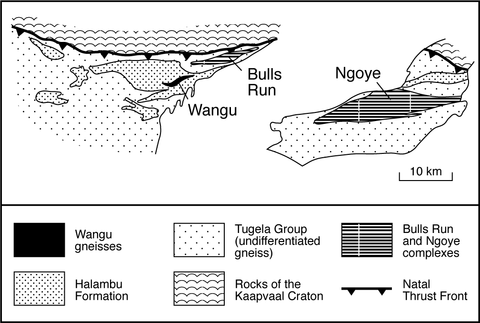stripes
The Bull's Run syenite-nepheline syenite gneiss complex is located within the approximately 1100 Ma Kibaran metamorphic belt of the Natal Structural and Metamorphic Province just south of the Kaapvaal Craton, from which it is separated by the Natal Thrust Front. The complex itself lies amongst amphibolites and granitic gneisses contacts with which may be mylonitised, although they are rarely exposed. Biotite-muscovite syenites form an outer envelope to most of the complex around a core of nepheline syenites. The envelope rock is a syenitic gneiss of albite, microcline, a little biotite, abundant muscovite, and accessory apatite, titanite and calcite. The nepheline gneisses consist of albite, microcline, nepheline, biotite, abundant scapolite, which in some rocks forms reaction zones between nepheline and calcite and, in an inner, fine-grained facies, small zircons occur. Gneissose dykes of microsyenite up to 2 m thick and several hundreds of metres long occur throughout the complex, but mainly in the muscovite-biotite syenites, and are characterised by the presence of aegirine and riebeckite. Three bodies of carbonate-rich gneisses, which are considered to be tectonically deformed carbonatites, have been located in the complex (Scogings and Forster, 1989). The most extensive occurrence is 100 m long and up to 20 m wide and intrudes muscovite syenitic gneiss, of which it contains xenoliths. A second occurrence is 200x1 m while the third consists of metre-long pods and veins. The carbonatites consist of abundant calcite, up to 96% by volume, variable amounts of microcline and albite, biotite and plentiful rounded apatites; accessories include ilmenite, pyrite, pyrochlore, which only occurs at the first locality, and rare zircon and muscovite. Analyses of four gneisses and five carbonatites, including trace elements for the latter with full rare earth element data for three of them, are available in Scogings and Forster (1989).
NICOLAYSEN, L.O. and BURGER, A.J. 1965. Note on an extensive zone of 1000 million-year old metamorphic and igneous rocks in southern Africa. Science de la Terre, Nancy, 10: 497-518.SCOGINGS, A.J. and FORSTER, I.F. 1989. Gneissose carbonatites in the Bull's Run Complex, Natal. South African Journal of Geology, 92: 1-10.

